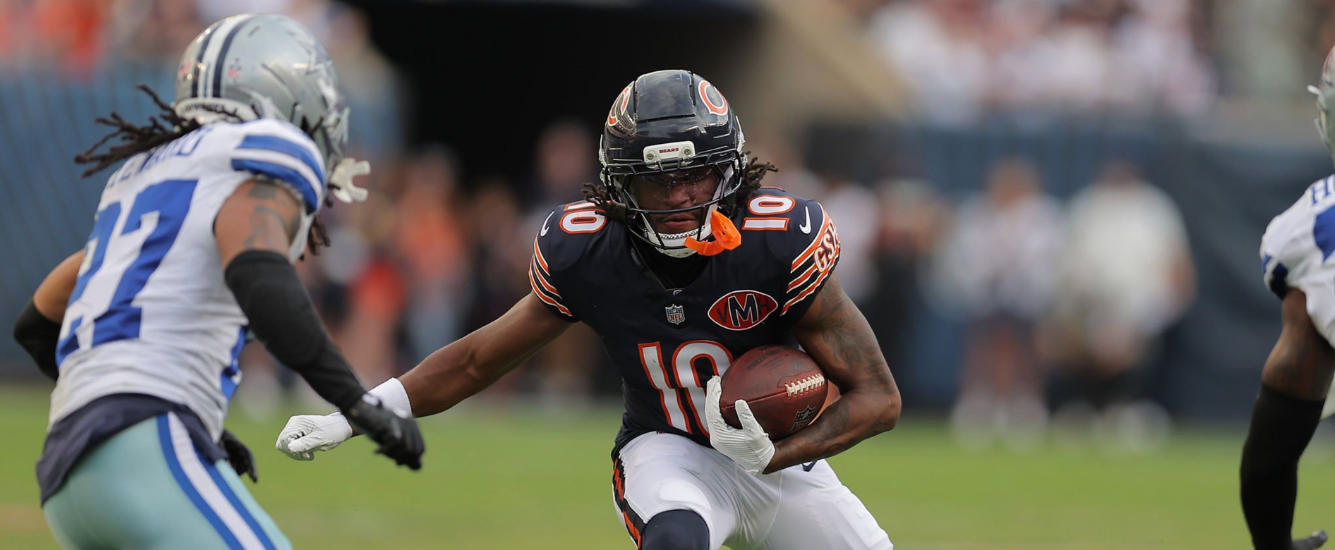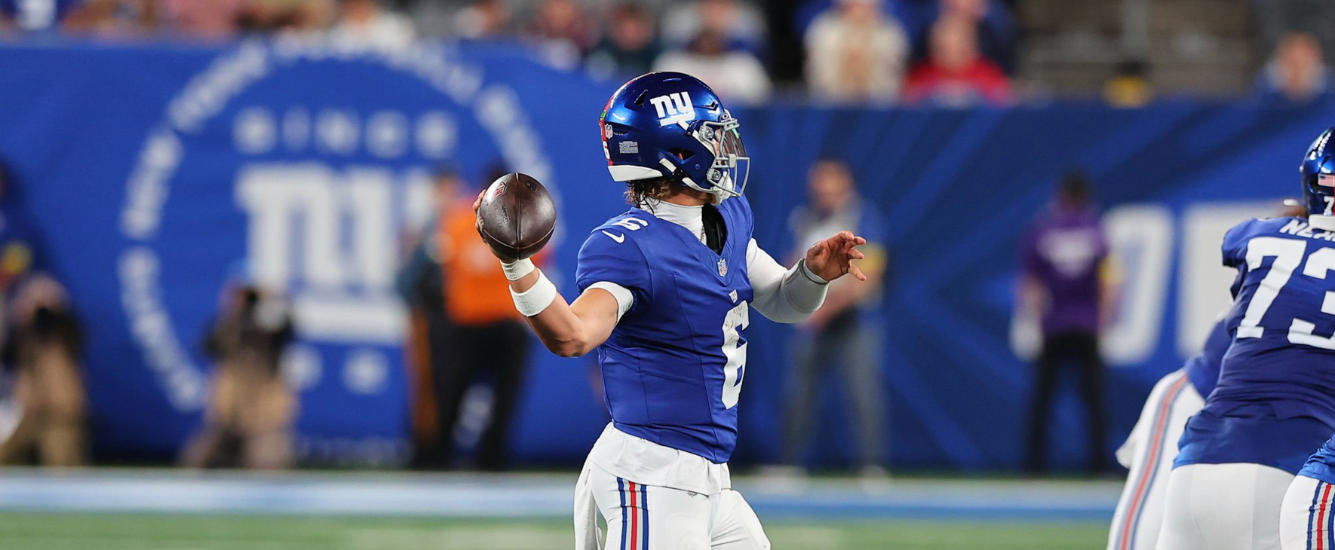Every year we add a layer to our analysis and predictive power in finding the best receiver prospects. In just a few short years we’ve discovered the importance of things like breakout age, dominator rating, yards per team pass attempt, and the Adjusted Production Index in predicting future NFL success.
The difficult part comes with putting all that information together for an incoming class and then making sense of it all given the context of who each wide receiver truly is as a player. But you’re in luck. We’ve already put together the Adjusted Production Index scores for 45 incoming rookie receivers so you don’t have to. We’ll try to decipher what that might mean for several of them.
But first, if you’re not familiar with the Adjusted Production Index, it’s simple. It’s a standardized and properly scaled combination of peak adjusted dominator, yards per team pass attempt, and touchdowns per team pass attempt.
Why “peak” production? Practically speaking, it gives us a look at a player’s best window of production even if the rest of their career was hampered by injury, redshirt years, or other unpredictable variables out of a player’s control. But also, using peak numbers is a bit of forward thinking as well. Thanks to the pandemic, the transfer portal, the new one-time transfer rule in college football, and rising totals of transfers, we’re going to see some odd production profile arcs and late breakouts from transfer receivers in the coming seasons.
But simply put, we’re looking at a player’s production profile from a few different angles that speak to their efficiency, market share potential, scoring ability, and dominance within the context of their team’s offense. If you want to learn more on the metric, check it out here and here! But for now, let’s dive into some of these receivers and their Adjusted Production Index scores.
Power 5 Conference Receivers
| Player | Adjusted Production Index | Percentile | Peak ADR | Peak ADR Z-Score | Peak AYPTA | Peak AYPTA Z-Score | Peak ATDPTA | Peak ATDPTA Z-Score |
|---|---|---|---|---|---|---|---|---|
| Devonta Smith | 6.17 | 98.5% | 47.3% | 1.188 | 4.377 | 2.050 | 0.054 | 2.932 |
| Elijah Moore | 3.82 | 93.1% | 45.5% | 1.035 | 4.451 | 2.132 | 0.030 | 0.655 |
| Chatarius Atwell | 3.58 | 90.9% | 38.1% | 0.393 | 4.240 | 1.899 | 0.037 | 1.291 |
| Rashod Bateman | 3.34 | 90.0% | 43.7% | 0.878 | 3.786 | 1.400 | 0.034 | 1.057 |
| Tylan Wallace | 3.27 | 89.8% | 47.5% | 1.203 | 3.613 | 1.211 | 0.032 | 0.856 |
| Sage Surratt | 2.66 | 85.7% | 44.9% | 0.982 | 3.090 | 0.636 | 0.034 | 1.038 |
| Ja'Marr Chase | 2.32 | 82.6% | 33.4% | -0.010 | 3.364 | 0.937 | 0.038 | 1.396 |
| Terrace Marshall | 2.12 | 80.7% | 46.5% | 1.117 | 2.480 | -0.033 | 0.034 | 1.036 |
| Josh Imatorbhebhe | 1.82 | 77.1% | 47.9% | 1.239 | 2.258 | -0.278 | 0.032 | 0.861 |
| Damon Hazelton Jr. | 1.53 | 73.2% | 38.1% | 0.393 | 2.394 | -0.129 | 0.036 | 1.260 |
| Dyami Brown | 1.37 | 71.9% | 30.6% | -0.250 | 3.358 | 0.931 | 0.030 | 0.690 |
| Jaylen Waddle | 0.98 | 64.3% | 28.9% | -0.399 | 3.624 | 1.223 | 0.025 | 0.158 |
| Rondale Moore | 0.35 | 53.7% | 37.3% | 0.323 | 2.472 | -0.043 | 0.024 | 0.069 |
| Tamorrion Terry | 0.27 | 53.3% | 35.8% | 0.199 | 2.750 | 0.263 | 0.021 | -0.187 |
| Shi Smith | 0.26 | 53.3% | 46.6% | 1.124 | 2.384 | -0.139 | 0.015 | -0.725 |
| Seth Williams | 0.09 | 50.9% | 38.3% | 0.415 | 2.282 | -0.251 | 0.022 | -0.078 |
| Amon-Ra St. Brown | -0.22 | 47.2% | 33.0% | -0.041 | 2.040 | -0.517 | 0.026 | 0.334 |
| Dazz Newsome | -0.23 | 47.1% | 27.6% | -0.507 | 2.565 | 0.059 | 0.025 | 0.220 |
| Ihmir Smith-Marsette | -0.85 | 36.6% | 37.9% | 0.375 | 1.761 | -0.824 | 0.019 | -0.404 |
| Kadarius Toney | -1.09 | 34.6% | 23.7% | -0.847 | 2.269 | -0.265 | 0.023 | 0.021 |
| Simi Fehoko | -1.26 | 32.8% | 34.2% | 0.060 | 1.711 | -0.878 | 0.018 | -0.438 |
| Nico Collins | -1.57 | 27.8% | 27.3% | -0.537 | 1.931 | -0.637 | 0.019 | -0.401 |
| Tyler Vaughns | -1.86 | 24.5% | 27.9% | -0.480 | 1.922 | -0.647 | 0.015 | -0.735 |
| Johnny Johnson III | -1.96 | 23.8% | 23.2% | -0.886 | 2.028 | -0.531 | 0.017 | -0.547 |
| Whop Philyor | -2.01 | 23.0% | 25.2% | -0.716 | 2.300 | -0.232 | 0.011 | -1.060 |
| Amari Rodgers | -2.09 | 22.3% | 23.5% | -0.863 | 2.107 | -0.443 | 0.014 | -0.782 |
| Anthony Schwartz | -2.37 | 19.5% | 28.2% | -0.458 | 1.938 | -0.629 | 0.009 | -1.278 |
| Jhamon Ausbon | -2.42 | 19.3% | 25.6% | -0.680 | 1.929 | -0.639 | 0.011 | -1.099 |
| Cornell Powell | -2.54 | 18.4% | 21.8% | -1.005 | 1.822 | -0.756 | 0.014 | -0.782 |
| Brennan Eagles | -3.06 | 15.0% | 18.0% | -1.337 | 1.515 | -1.094 | 0.016 | -0.624 |
| Tarik Black | -5.70 | 0.1% | 8.2% | -2.178 | 0.933 | -1.733 | 0.004 | -1.793 |
Non-Power 5 Conference Receivers
| Player | Adjusted Production Index | Percentile | Peak ADR | Peak ADR Z-Score | Peak AYPTA | Peak AYPTA Z-Score | Peak ATDPTA | Peak ATDPTA Z-Score |
|---|---|---|---|---|---|---|---|---|
| Jaelon Darden | 7.28 | 99.0% | 56.5% | 1.984 | 3.935 | 1.564 | 0.063 | 3.734 |
| D'Wayne Eskridge | 6.34 | 98.6% | 44.8% | 0.969 | 4.955 | 2.684 | 0.052 | 2.686 |
| Cade Johnson | 5.16 | 98.0% | 44.7% | 0.967 | 4.156 | 1.807 | 0.048 | 2.389 |
| Isaiah McKoy | 2.95 | 88.2% | 35.4% | 0.166 | 3.611 | 1.208 | 0.040 | 1.573 |
| Marlon Williams | 2.55 | 85.1% | 37.7% | 0.361 | 3.130 | 0.680 | 0.039 | 1.515 |
| Marquez Stevenson | 1.75 | 76.6% | 42.3% | 0.754 | 2.908 | 0.436 | 0.029 | 0.561 |
| Warren Jackson | 1.11 | 67.3% | 41.2% | 0.661 | 3.024 | 0.564 | 0.022 | -0.113 |
| Jonathan Adams Jr. | 0.56 | 56.7% | 32.2% | -0.116 | 2.640 | 0.141 | 0.029 | 0.530 |
| Austin Watkins | 0.41 | 55.1% | 34.4% | 0.076 | 3.240 | 0.801 | 0.018 | -0.470 |
| Dax Milne | 0.01 | 50.5% | 26.7% | -0.589 | 3.176 | 0.731 | 0.021 | -0.135 |
| Damonte Coxie | -0.12 | 48.2% | 29.7% | -0.325 | 2.900 | 0.427 | 0.020 | -0.222 |
| Tre Walker | -1.37 | 30.7% | 23.7% | -0.848 | 2.798 | 0.315 | 0.014 | -0.835 |
| Tre Nixon | -2.22 | 20.8% | 21.5% | -1.038 | 1.968 | -0.597 | 0.017 | -0.583 |
Why split wide receivers up by college conference designation? Frankly, small school wide receivers have a significantly lower hit rate and a fewer shots at meaningful draft capital. And one of the useful things the Adjusted Production Index does is help predict capital, especially when it comes to Power 5 Conference receivers. Let’s take a quick look at most all receivers drafted since 2005 by Adjusted Production Index and draft capital.
All Receivers

Power 5 Receivers

No this doesn’t mean lower level conference players can’t hit. It just means a little less for those players to hit high Adjusted Production Index (or any production metric) thresholds in terms of predicting draft capital. So, let’s start with a few Power 5 receivers first. But before we do, a few takeaways found in Adjusted Production Index research:
– Players that score in the 60th percentile or better among drafted NFL players have a significantly higher hit rate and typically have longer careers.
– 50th percentile is the cutoff for likely hits with draft capital included.
– Anything below 30th percentile is a “near impossible to hit” prospect. The only way they hit is with Day 2 draft capital or better.
Keep in mind this isn’t a straight down-the-line rookie rankings list. It’s strictly Adjusted Production Index percentiles. Now, let’s dive in.




















